Jin dynasty (1115–1234)
Great Jin | |||||||||||||||||||||
|---|---|---|---|---|---|---|---|---|---|---|---|---|---|---|---|---|---|---|---|---|---|
| 1115–1234 | |||||||||||||||||||||
 Location of Jin dynasty (blue ) c. 1141
| |||||||||||||||||||||
 Circuits of Jin | |||||||||||||||||||||
| Capital | |||||||||||||||||||||
| Common languages | Middle Chinese (later Old Mandarin), Jurchen, Khitan | ||||||||||||||||||||
| Religion | |||||||||||||||||||||
| Government | Monarchy | ||||||||||||||||||||
Emperor | |||||||||||||||||||||
• 1115–1123 | Taizu (first) | ||||||||||||||||||||
• 1161–1189 | Shizong | ||||||||||||||||||||
• 1234 | Modi (last) | ||||||||||||||||||||
| Historical era | Northern Song dynasty | 9 January 1127 | |||||||||||||||||||
• Mongol invasion | 1211 | ||||||||||||||||||||
| 9 February 1234 | |||||||||||||||||||||
| Area | |||||||||||||||||||||
| 1142 est. | 3,610,000 km2 (1,390,000 sq mi) | ||||||||||||||||||||
| 1186 est. | 4,750,000 km2 (1,830,000 sq mi) | ||||||||||||||||||||
| Population | |||||||||||||||||||||
• 1186 est.[1] | 53,000,000 | ||||||||||||||||||||
| Currency |
| ||||||||||||||||||||
| |||||||||||||||||||||
| Today part of | |||||||||||||||||||||
| Part of a series on the |
| History of China |
|---|
The Jin dynasty (/dʒɪn/,[2] [tɕín]; Chinese: 金朝; pinyin: Jīn cháo),[a] officially known as the Great Jin (大金; Dà Jīn), was an imperial dynasty of China that existed between 1115 and 1234.[b] Because the Wanyan clan that founded the dynasty were of Jurchen descent, it is also sometimes called the Jurchen dynasty or the Jurchen Jin.
The Jin dynasty emerged from Wanyan Aguda's rebellion against the Liao dynasty (916–1125), which held sway over northern China until being driven by the nascent Jin to the Western Regions, where they would become known in Chinese historiography as the Western Liao. After conquering the Liao territory, the Jin launched a century-long campaign against the Song dynasty (960–1279) based in southern China, and whose rulers were ethnically Han Chinese. Over the course of the Jin's rule, their emperors adapted to Han customs, and even fortified the Great Wall against the ascendant Mongol Empire. The Jin also oversaw a number of internal cultural advancements, such as the revival of Confucianism.
After spending centuries in vassalage under the Jin, the Mongols under Genghis Khan invaded in 1211, inflicting several crushing defeats upon Jin armies. After a sequence of defeats, revolts, defections, and coups over a span of 23 years, the Jin were ultimately conquered by the Mongols in 1234.
Name
The Jin dynasty was officially known as the "Great Jin" at that time. Furthermore, the Jin emperors referred to their state as China, Zhongguo (中國), just as some other non-Han dynasties.[6] Non-Han rulers expanded the definition of "China" to include non-Han peoples in addition to Han people whenever they ruled China.[7] Jin documents indicate that the usage of "China" by dynasties to refer to themselves began earlier than previously thought.[8]
History
| Jin dynasty | |
|---|---|
| Chinese name | |
Hanyu Pinyin | Dà Jīn |
| Bopomofo | ㄉㄚˋ ㄐㄧㄣ |
| Wade–Giles | Ta4 Chin1 |
| Tongyong Pinyin | Dà Jin |
| IPA | [tâ.tɕín] |
| Yue: Cantonese | |
| Jyutping | daai6 gam1 |
| IPA | [taːi˨ kɐm˥] |
Origin
The Mohe were the ancestors of the Jin. the Mohe were called Wuji, the Wuji lived on the land of the Sushen people. There are seven Wuji tribes: Sumo, Boduo, Anchegu, Funie, Haoshi, Heishui, Baishan.
The progenitors of the
The two most powerful groups of Mohe were the
In the 11th century there was widespread discontent against
Wanyan Aguda
The Jin dynasty was created in modern
Having conquered Kaifeng and occupied northern China, the Jin later deliberately chose earth as its dynastic element and yellow as its royal color. According to the theory of the wuxing ('five elements'), the earth element follows the fire, the dynastic element of the Song, in the sequence of elemental creation. Therefore, this ideological move shows that the Jin regarded the Song reign of China was officially over and themselves as the rightful ruler of China Proper.[23]
Migration south
After taking over northern China, the Jin became increasingly
Following the death of Emperor Taizong in 1135, each of the next three emperors were the remaining grandsons of Aguda, each by a different one of his sons. Emperor Xizong (r. 1135–1149) studied the classics and wrote Chinese poetry. He adopted Han Chinese cultural traditions, but the Jurchen nobles had the top positions. Later in life, Emperor Xizong became an alcoholic and executed many officials for criticising him. He also had Jurchen leaders who opposed him murdered, even those in the Wanyan clan. In 1149 he was murdered by a cabal of relatives and nobles, who made his cousin Wanyan Liang the next Jin emperor. Because of the brutality of both his domestic and foreign policy, Wanyan Liang was posthumously demoted from the position of emperor. Historians have consequently referred to him by his posthumous name "Prince of Hailing".[25]
Rebellions in the north
Having usurped the throne,
Wanyan Liang also tried to suppress dissent by killing Jurchen nobles, executing 155 princes.
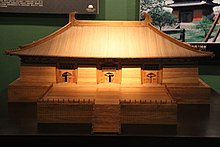

Although crowned in October, Wanyan Yong (Emperor Shizong) was not officially recognised as emperor until the murder of Wanyan Liang's heir.[25] The Khitan uprising was not suppressed until 1164; their horses were confiscated so that the rebels had to take up farming. Other Khitan and Xi cavalry units had been incorporated into the Jin army. Because these internal uprisings had severely weakened the Jin's capacity to confront the Southern Song militarily, the Jin court under Emperor Shizong began negotiating for peace. The Treaty of Longxing was signed in 1164, ushering in more than 40 years of peace between the two empires.
In the early 1180s, Emperor Shizong instituted a restructuring of 200 meng'an units to remove tax abuses and help Jurchens. Communal farming was encouraged. The Jin Empire prospered and had a large surplus of grain in reserve. Although learned in
Shizong's grandson, Emperor Zhangzong (r. 1189–1208), venerated Jurchen values, but he also immersed himself in Han Chinese culture and married an ethnic Han Chinese woman. The Taihe Code of law was promulgated in 1201 and was based mostly on the Tang Code. In 1207, the Southern Song dynasty attempted an invasion, but the Jin forces effectively repulsed them. In the peace agreement, the Song dynasty had to pay higher annual indemnities and behead Han Tuozhou, the leader of the hawkish faction in the Song imperial court.
Fall of Jin
Starting from the early 13th century, the Jin dynasty began to feel the pressure of Mongols from the north. Genghis Khan first led the Mongols into Western Xia territory in 1205 and ravaged it four years later. In 1211 about 50,000 Mongol horsemen invaded the Jin Empire and began absorbing Khitan and Jurchen rebels. The Jin had a large army with 150,000 cavalry but abandoned the "western capital" Datong (see also the Battle of Yehuling). The next year the Mongols went north and looted the Jin "eastern capital", and in 1213 they besieged the "central capital", Zhongdu (present-day Beijing). In 1214 the Jin made a humiliating treaty but retained the capital. That summer, Emperor Xuanzong abandoned the central capital and moved the government to the "southern capital" Kaifeng, making it the official seat of the Jin dynasty's power.
In 1216, a hawkish faction in the Jin imperial court persuaded Emperor Xuanzong to attack the Song dynasty, but in 1219 they were defeated at the same place by the
The Jurchen Jin emperor Wanyan Yongji's daughter, Jurchen Princess Qiguo was married to Mongol leader Genghis Khan in exchange for relieving the Mongol siege of Zhongdu in the Mongol conquest of the Jin dynasty.[29]
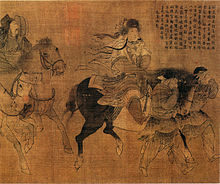
Many
Shi Tianze was a Han Chinese who lived under Jin rule. Inter-ethnic marriage between Han Chinese and Jurchens became common at this time. His father was Shi Bingzhi. Shi Bingzhi married a Jurchen woman (surname Nahe) and a Han Chinese woman (surname Zhang); it is unknown which of them was Shi Tianze's mother.[38] Shi Tianze was married to two Jurchen women, a Han Chinese woman, and a Korean woman, and his son Shi Gang was born to one of his Jurchen wives.[39] His Jurchen wives' surnames were Monian and Nahe, his Korean wife's surname was Li, and his Han Chinese wife's surname was Shi.[38] Shi Tianze defected to the Mongol forces upon their invasion of the Jin dynasty. His son, Shi Gang, married a Keraite woman; the Keraites were Mongolified Turkic people and considered as part of the "Mongol nation".[39][40] Shi Tianze, Zhang Rou, Yan Shi and other Han Chinese who served in the Jin dynasty and defected to the Mongols helped build the structure for the administration of the new Mongol state.[41]
The Mongols created a Han army out of defecting Jin troops, and another army out of defected Song troops called the "Newly Submitted Army" (新附軍).[42]
Genghis Khan died in 1227 while his armies were attacking Western Xia. His successor, Ögedei Khan, invaded the Jin dynasty again in 1232 with assistance from the
In Empire of The Steppes, René Grousset reports that the Mongols were always amazed at the valour of the Jurchen warriors, who held out until seven years after the death of Genghis Khan.
Military
The Jin dynasty's standing forces numbered at approximately half a million, the largest in the world at the time, circa 1195. In the view of some scholars such as H. D. Martin, they were also the most powerful force at the time.
In its initial years, the Jin dynasty's armies contained 70 to 90% cavalry. Although the Jurchen were avid horse breeders who owned normal-sized horses, they used small horses for warfare. These small horses, like Yakutian and Mongolian horse breeds, were adapted to temperatures ranging from 40 degrees Celsius to negative 60 degrees Celsius, making them suited to military campaigns in central China during autumn and winter, as well as on the Mongolian steppe. Each Jurchen horseman joined the campaign with two horses, one for battle and one for transport. Each horseman was accompanied by a relative who served as his ališi (armour-bearer), who also brought two horses, one for riding and one to carry baggage.[47]
Military technology
As the Liao dynasty fell apart and the Song dynasty retreated beyond the
On the other hand, the Jin military was not particularly good at naval warfare. Both in 1129–30 and in 1161 Jin forces were defeated by the
In 1130, the Jin army reached Hangzhou and Ningbo in southern China. But heavy Chinese resistance and the geography of the area halted the Jin advance, and they were forced to retreat and withdraw, and they had not been able to escape the Song navy when trying to return until they were directed by a Han Chinese defector who helped them escape in Zhenjiang. Southern China was then cleared of the Jurchen forces.[51][52]
Organisation structure
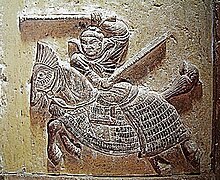
The Jin military was organised through the meng-an mou-k'o (meng'an mouke) system, seemingly similar to the later Eight Banners of the Qing dynasty. Meng-an is from the Mongol word for thousand, mingghan (see Military of the Yuan dynasty) while mou-k'o means clan or tribe. Groups of fifty households known as p'u-li-yen were grouped together as a mou-k'o, while seven to ten mou-k'o formed a meng-an, and several meng-an were grouped into a wanhu, Chinese for Ten Thousand Households. This was not only a military structure but also grouped all Jurchen households for economic and administrative functions. Khitans and Han Chinese soldiers who had defected to the Jin dynasty were also assigned into their own meng-an. All male members of the households were required to serve in the military; the servants of the household would serve as auxiliaries to escort their masters in battle. The numbers of Han Chinese soldiers in the Jin's armies seemed to be very significant.[53] Although mouke technically meant clan, their members were not necessarily related by blood; the word denoted a hunting or herding group, and was formed for administrative purposes. However, their offices were hereditary.[54]
The headships of the meng-an were initially the economic basis of the Jurchen aristocracy; some of the meng-an became private armies of hereditary imperial princes, seizing properties and challenging the throne. Jurchen military commanders were largely hereditary Jurchen nobles, and were given power over the local civilian governors where they were garrisoned. Prince Hailing abolished these autonomous positions, brutally suppressing potential threats, and thus established a more centralized Chinese-style model.[50] In 1140 sedentary populations such as the Han and Bohai were discharged from the meng-an system, and in 1163 the Khitans were discharged due to rebellion, although the Khitans who remained loyal were declared exempted from removal a few months later.[55] The mouke system helped to maintain walled compounds of horse herds to ensure a steady supply of horses for the cavalrymen and their armour-bearers.[47]
Ethnic Bohai were an important element of not only civil but military administration in the Jin dynasty from its earliest stages. After annexing the Bohai rebel regime of Gao Yongchang, the Jin moved to attract Bohai recruits by sending out two Bohai, Liang Fu (梁福) and Wodala (斡荅剌) to encourage their compatriots to join the Jin, using the slogan "Jurchen and Bohai are originally of the same family" (女真渤海本同一家). Da Gao (大㚖), a descendant of Bohai royalty, was a major military commander in the Jin, commanding eight meng-an of Bohai troops, and excelled in battle against the Song army. The Bohai were admired for their martial skills: "full of cunning, surpassing other nations in courage."[56] Bohai likely had a system of organisation similar to the meng'an mouke as early as 926, when they fled the destruction of their state in groups of 100, 300 and 500 households.[47]
After the meng-an forces declined in effectiveness, ad hoc Chinese irregulars called Zhongxiao Jun (filial and loyal troops) were raised to fight the Mongols. They were known for their courage but also ill-discipline.[48] The Zhongxiao Jun also included Uyghur, Tuyuhun, Qiang and Naiman troops, who were defectors and captives enlisting with the Jin forces.[57]
The head of a tribal alliance was called "Dubojilie" (都勃极列, from Jurchen du meaning “head”), his assistant was the "Anbanbojilie" (amban, Jurchen for minister), the chief minister was a "Guolunbojilie" (from gurun, Jurchen for state), and the title of an army commander was "Hulubojilie" (忽魯勃極列, from Jurchen gurun begile), and a tribal chief was titled "Bojilie".[58] Before declaring the formation of the Jin and claiming the title of emperor, the Jurchen ruler used the title of "Dubojilie".[59] When the population was mobilized for war, the Bojilie took on military command of the meng-an, which was the name of both the military unit and the title of its commander. The leadership of the dynasty was directed by the Council of Great Chieftains (Bojilie) until 1134 when Wuqimai dismantled it.[60]
Jin Great Wall
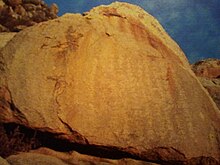
In order to prevent incursion from the Mongols, a large construction program was launched. The records show that two important sections of the Great Wall were completed by the Jurchens.
The Great Wall as constructed by the Jurchens differed from the previous dynasties. Known as the Border Fortress or the Boundary Ditch of the Jin, it was formed by digging ditches and using the excavated earth to build lengths of earthen parapet.[61] The southern branch of the southern wall had a secondary ditch dug along the interior, south-facing side of the wall. The History of Jin refers to the defences as “jiehao” (界壕, boundary trench), or “haoqian” (壕堑, trench chasm/moat), and the act of constructing them as jun (浚, digging), terms which focus on the ditch more than the wall.[62] In some places subsidiary walls and ditches were added for extra strength. The construction was started in about 1123 and completed by about 1198. The two sections attributable to the Jin dynasty are known as the Old Mingchang Walls and New Great Walls, together stretching more than 2,000 kilometres in length.[verification needed]
However, there is no evidence that the wall system was manned at the time of the Mongol attack. The lack of soldiers at the walls may be related to the fact that guarding the wall was the responsibility of the Ongguts, who defected early on to the Mongols. Moreover, even during the Jin dynasty, one minister complained that the walls were a waste of money because they were not solid enough to withstand the desert sandstorms.[43]
Government
The government of the Jin dynasty merged Jurchen customs with institutions adopted from the Liao and Song dynasties.[63] The pre-dynastic Jurchen government was based on the quasi-egalitarian tribal council.[64] Jurchen society at the time did not have a strong political hierarchy. The Shuo Fu (說郛) records that the Jurchen tribes were not ruled by central authority and locally elected their chieftains.[63] Tribal customs were retained after Aguda united the Jurchen tribes and formed the Jin dynasty, coexisting alongside more centralised institutions.[65] The Jin dynasty had five capitals, a practice they adopted from the Balhae and the Liao.[66] The Jin had to overcome the difficulties of controlling a multicultural empire composed of territories once ruled by the Liao and Northern Song. The solution of the early Jin government was to establish separate government structures for different ethnic groups.[67]
The Jin court maintained a clear separation between the sedentary population who had lived under Liao rule, and the sedentary population who formerly lived under Northern Song rule but had never been under Liao rule. The former they referred to as hanren or yanren while the latter they referred to as nanren.[68]
Culture
Because the Jin had few contacts with its southern neighbour, the Song dynasty, different cultural developments took place in both states. Within Confucianism, the "Learning of the Way" that developed and became orthodox in Song did not take root in Jin. Jin scholars put more emphasis on the work of northern Song scholar and poet Su Shi (1037–1101) than on Zhu Xi's (1130–1200) scholarship, which constituted the foundation of the Learning of the Way.[69]
Architecture
The Jin pursued a revival of Tang dynasty urban design with architectural projects in Kaifeng and Zhongdu (modern Beijing), building for instance a bell tower and drum tower to announce the night curfew (which was revived after being abolished under the Song).[70] The Jurchens followed Khitan precedent of living in tents amidst the Chinese-style architecture, which were in turn based on the Song dynasty Kaifeng model.[71]
Religion
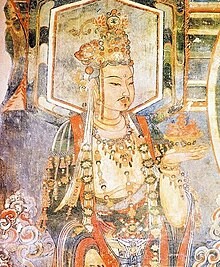
Taoism
This section may require copy editing. (March 2024) |
A significant branch of
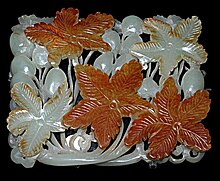


The Jin state sponsored an edition of the
Buddhism
A
Buddhism thrived during the Jin, both in its relation with the imperial court and in society in general.
Fashion
List of emperors
| Temple name | Posthumous name1 | Jurchen name | Chinese name | Years of reign | Era names and years |
|---|---|---|---|---|---|
| Taizu (太祖) | Wuyuan (武元) | Aguda (阿骨打) | Min (旻) | 1115–1123 | Shouguo (收國; 1115–1116) Tianfu (天輔; 1117–1123) |
| Taizong (太宗) | Wenlie (文烈) | Wuqimai (吳乞買) | Sheng (晟) | 1123–1135 | Tianhui (天會; 1123–1135) |
| Xizong (熙宗) | Xiaocheng (孝成) | Hela (合剌) | Dan (亶) | 1135–1149 | Tianhui (天會; 1135–1138) Tianjuan (天眷; 1138–1141) Huangtong (皇統; 1141–1149) |
| None | – | Digunai (迪古乃) | Liang (亮) | 1149–1161 | Tiande (天德, 1149–1153) Zhenyuan (貞元; 1153–1156) Zhenglong (正隆; 1156–1161) |
| Shizong (世宗) | Renxiao (仁孝) | Wulu (烏祿) | Yong (雍) | 1161–1189 | Dading (大定; 1161–1189) |
| Zhangzong 章宗 |
Guangxiao (光孝) | Madage (麻達葛) | Jing (璟) | 1189–1208 | Mingchang (明昌; 1190–1196) Cheng'an (承安; 1196–1200) Taihe (泰和; 1200–1208) |
| None | – | Unknown | Yongji (永濟) | 1208–1213 | Da'an (大安; 1209–1212) Chongqing (崇慶; 1212–1213) Zhining (至寧; 1213) |
| Xuanzong 宣宗 |
Shengxiao (聖孝) | Wudubu (吾睹補) | Xun (珣) | 1213–1224 | Zhenyou (貞祐; 1213–1217) Xingding (興定; 1217–1222) Yuanguang (元光; 1222–1224) |
| Aizong (哀宗, official) Zhuangzong (莊宗, unofficial) Minzong (閔宗, unofficial) Yizong (義宗, unofficial) |
None | Ningjiasu (寧甲速) | Shouxu (守緒) | 1224–1234 | Zhengda (正大; 1224–1232) Kaixing (開興; 1232) Tianxing (天興; 1232–1234) |
| None | None | Hudun (呼敦) | Chenglin (承麟) | 1234 | Shengchang (盛昌; 1234) |
| 1: For full posthumous names, see the articles for individual emperors. | |||||
Emperors family tree
| Emperors family tree | |||||||||||||||||||||||||||||||||||||||||||||||||||||||||||||||||||||||||||||||||||||||||||||||||||||||||||||||||||||||||||||||||||||||||||||||||||||||||||||||||||||||||||||||||||||||||||||||||||||||||||||||||||||||||||||||||||||||||||||||||||||||||||||||||||||||||||||||||||||||||||||||||||||||||||||||||||||||||||||||||||||||||||||||||||||||||||||||||||||||||||||||||||||||||||||||||||||||||||||||||||||||||||||||||||||||||||||||||||||||||||||||||||||||||||||||||||||||||||||||||||||||||||||||||||||||||||||||||||||||||||||||||||||||||||||||||||||||||||||||||||||||||||||||||||||||||||||||||||||||||||||||||||||||||||||||||||||||||||||||||||||||||||||||||||||||||||||||||||||||||||||||||||||||||||||||||||||||||||||||||||||||||||||||||||||||||||||||||||||||||||||||||||||||||||||||||||||||||||||||||||||||||||||||||||||||||||||||||||||||||||||||||||||||||||||||||||||||||||||||||||||||||||||||||||||||||||||||||||||||||||||||||||||||||||||||||||||||||||||||||||||||||||||||||||||||||||||||||||||||
|---|---|---|---|---|---|---|---|---|---|---|---|---|---|---|---|---|---|---|---|---|---|---|---|---|---|---|---|---|---|---|---|---|---|---|---|---|---|---|---|---|---|---|---|---|---|---|---|---|---|---|---|---|---|---|---|---|---|---|---|---|---|---|---|---|---|---|---|---|---|---|---|---|---|---|---|---|---|---|---|---|---|---|---|---|---|---|---|---|---|---|---|---|---|---|---|---|---|---|---|---|---|---|---|---|---|---|---|---|---|---|---|---|---|---|---|---|---|---|---|---|---|---|---|---|---|---|---|---|---|---|---|---|---|---|---|---|---|---|---|---|---|---|---|---|---|---|---|---|---|---|---|---|---|---|---|---|---|---|---|---|---|---|---|---|---|---|---|---|---|---|---|---|---|---|---|---|---|---|---|---|---|---|---|---|---|---|---|---|---|---|---|---|---|---|---|---|---|---|---|---|---|---|---|---|---|---|---|---|---|---|---|---|---|---|---|---|---|---|---|---|---|---|---|---|---|---|---|---|---|---|---|---|---|---|---|---|---|---|---|---|---|---|---|---|---|---|---|---|---|---|---|---|---|---|---|---|---|---|---|---|---|---|---|---|---|---|---|---|---|---|---|---|---|---|---|---|---|---|---|---|---|---|---|---|---|---|---|---|---|---|---|---|---|---|---|---|---|---|---|---|---|---|---|---|---|---|---|---|---|---|---|---|---|---|---|---|---|---|---|---|---|---|---|---|---|---|---|---|---|---|---|---|---|---|---|---|---|---|---|---|---|---|---|---|---|---|---|---|---|---|---|---|---|---|---|---|---|---|---|---|---|---|---|---|---|---|---|---|---|---|---|---|---|---|---|---|---|---|---|---|---|---|---|---|---|---|---|---|---|---|---|---|---|---|---|---|---|---|---|---|---|---|---|---|---|---|---|---|---|---|---|---|---|---|---|---|---|---|---|---|---|---|---|---|---|---|---|---|---|---|---|---|---|---|---|---|---|---|---|---|---|---|---|---|---|---|---|---|---|---|---|---|---|---|---|---|---|---|---|---|---|---|---|---|---|---|---|---|---|---|---|---|---|---|---|---|---|---|---|---|---|---|---|---|---|---|---|---|---|---|---|---|---|---|---|---|---|---|---|---|---|---|---|---|---|---|---|---|---|---|---|---|---|---|---|---|---|---|---|---|---|---|---|---|---|---|---|---|---|---|---|---|---|---|---|---|---|---|---|---|---|---|---|---|---|---|---|---|---|---|---|---|---|---|---|---|---|---|---|---|---|---|---|---|---|---|---|---|---|---|---|---|---|---|---|---|---|---|---|---|---|---|---|---|---|---|---|---|---|---|---|---|---|---|---|---|---|---|---|---|---|---|---|---|---|---|---|---|---|---|---|---|---|---|---|---|---|---|---|---|---|---|---|---|---|---|---|---|---|---|---|---|---|---|---|---|---|---|---|---|---|---|---|---|---|---|---|---|---|---|---|---|---|---|---|---|---|---|---|---|---|---|---|---|---|---|---|---|---|---|---|---|---|---|---|---|---|---|---|---|---|---|---|---|---|---|---|---|---|---|---|---|---|---|---|---|---|---|---|---|---|---|---|---|---|---|---|---|---|---|---|---|---|---|---|---|---|---|---|---|---|---|---|---|---|---|---|---|---|---|---|---|---|---|---|---|---|---|---|---|---|---|---|---|---|---|---|---|---|---|---|---|---|---|---|---|---|---|---|---|---|---|---|---|---|---|---|---|---|---|---|---|---|---|---|---|---|---|---|---|---|---|---|---|---|---|---|---|---|---|---|---|---|---|---|---|---|---|---|---|---|---|---|---|---|---|---|---|---|---|---|---|---|---|---|---|---|---|---|---|---|---|---|---|---|---|---|---|---|---|---|---|---|---|---|---|---|---|---|---|---|---|---|---|---|---|---|---|---|---|---|---|---|---|---|---|---|---|---|---|---|---|---|---|---|---|---|---|---|---|---|---|---|---|---|---|---|---|---|---|---|---|---|---|---|---|---|---|---|---|---|---|---|---|---|---|---|---|---|---|---|---|---|---|---|---|---|---|---|---|---|---|---|---|---|---|---|---|---|---|---|---|---|---|---|---|---|---|---|---|---|---|---|---|---|---|---|---|---|---|---|---|---|---|---|---|---|---|---|---|---|---|---|---|---|---|---|---|---|---|---|---|---|---|---|---|---|---|---|---|---|---|---|---|---|---|---|---|---|---|---|---|---|---|---|---|---|---|---|---|---|---|---|---|---|---|---|---|---|
| |||||||||||||||||||||||||||||||||||||||||||||||||||||||||||||||||||||||||||||||||||||||||||||||||||||||||||||||||||||||||||||||||||||||||||||||||||||||||||||||||||||||||||||||||||||||||||||||||||||||||||||||||||||||||||||||||||||||||||||||||||||||||||||||||||||||||||||||||||||||||||||||||||||||||||||||||||||||||||||||||||||||||||||||||||||||||||||||||||||||||||||||||||||||||||||||||||||||||||||||||||||||||||||||||||||||||||||||||||||||||||||||||||||||||||||||||||||||||||||||||||||||||||||||||||||||||||||||||||||||||||||||||||||||||||||||||||||||||||||||||||||||||||||||||||||||||||||||||||||||||||||||||||||||||||||||||||||||||||||||||||||||||||||||||||||||||||||||||||||||||||||||||||||||||||||||||||||||||||||||||||||||||||||||||||||||||||||||||||||||||||||||||||||||||||||||||||||||||||||||||||||||||||||||||||||||||||||||||||||||||||||||||||||||||||||||||||||||||||||||||||||||||||||||||||||||||||||||||||||||||||||||||||||||||||||||||||||||||||||||||||||||||||||||||||||||||||||||||||||||
See also
| History of Manchuria |
|---|
 |
- Eastern Xia
- Jurchen Jin emperors family tree
- Korean–Jurchen border conflicts
- Timeline of the Jin–Song Wars
Notes
References
Citations
- ^ Twitchett & Fairbank 1994, p. 40.
- ^ "Jin". Random House Webster's Unabridged Dictionary.
- ISBN 978-0-8135-1304-1
- ^ Franke 1994b, pp. 215–320.
- ISBN 978-0-595-12578-4, retrieved 28 June 2014
- ^ Zhao 2006, p. 7.
- ^ Zhao 2006, p. 6.
- ^ Zhao 2006, p. 24.
- ^ Gorelova 2002, pp. 13–14.
- ^ Crossley 1997, p. 17.
- ^ Crossley 1997, p. 124.
- ^ Crossley 1997, p. 18–20.
- ^ Franke 1994b, p. 217–220.
- ^ Breuker 2010, pp. 220–221.
- ^ Franke 1994b, p. 220.
- ^ a b Franke 1994b, p. 221.
- ^ Franke 1994a, p. 39.
- ^ Tillman 1995a, pp. 28–.
- ^ Elliott, Mark (2012), "8. Hushuo The Northern Other and the Naming of the Han Chinese" (PDF), in Mullaney, Tomhas S.; Leibold, James; Gros, Stéphane; Bussche, Eric Vanden (eds.), Critical Han Studies The History, Representation, and Identity of China's Majority, University of California Press, p. 186
- ^ Gernet 1996, pp. 358–.
- ISBN 978-0-231-11004-4
- ^ Mark C. Elliot (2001), The Manchu Way: The eight banners and ethnic identity in late imperial China, Stanford University Press, p. 60
- ^ a b c d e f g h Beck, Sanderson, "Liao, Xi Xia, and Jin Dynasties 907–1234", China 7 BC To 1279
- ^ a b Tao (1976), p. 44
- ^ Tao (1976), Chapter 6. "The Jurchen Movement for Revival", pp. 69–83
- S2CID 162237648, retrieved 31 March 2023 – via JSTOR
- ISBN 978-1-108-63662-9.
- ^ Collectif (2002). Revue bibliographique de sinologie 2001. Éditions de l'École des hautes études en sciences sociales. p. 147.
- ^ May, Timothy Michael (2004). The Mechanics of Conquest and Governance: The Rise and Expansion of the Mongol Empire, 1185–1265. University of Wisconsin–Madison. p. 50.
- ^ Schram, Stuart Reynolds (1987). Foundations and Limits of State Power in China. European Science Foundation by School of Oriental and African Studies, University of London. p. 130.
- ^ Gary Seaman; Daniel Marks (1991). Rulers from the steppe: state formation on the Eurasian periphery. Ethnographics Press, Center for Visual Anthropology, University of Southern California. p. 175.
- from the original on 2 August 2016. Retrieved 3 May 2016.
- ^ "窝阔台汗己丑年汉军万户萧札剌考辨–兼论金元之际的汉地七万户-国家哲学社会科学学术期刊数据库". Archived from the original on 13 April 2020. Retrieved 3 May 2016.
- ^ "新元史/卷146 – 維基文庫,自由的圖書館". zh.wikisource.org.
- ^ "作品相关 第二十九章 大库里台. 本章出自《草原特种兵》" [Chapter 29 Big Curry Terrace. This chapter is from Grassland Special Forces] (in Chinese). Archived from the original on 4 March 2016. Retrieved 3 May 2016.
- ^ a b Igor de Rachewiltz, ed. (1993). In the Service of the Khan: Eminent Personalities of the Early Mongol-Yüan Period (1200–1300). Otto Harrassowitz Verlag. p. 41.
- ^ a b J. Ganim; S. Legassie, eds. (2013). Cosmopolitanism and the Middle Ages. Springer. p. 47.
- ^ Watt, James C. Y. (2010). The World of Khubilai Khan: Chinese Art in the Yuan Dynasty. Metropolitan Museum of Art. p. 14.
- S2CID 161851226.
- ^ Hucker, Charles O. (1985). A Dictionary of Official Titles in Imperial China. Stanford University Press. p. 66.
- ^ ISBN 9781783400560.
- ^ a b c d e Tao (1976), Chapter 2. "The Rise of the Chin dynasty", pp. 21–24
- ISBN 9781473830110.
- ISBN 9781913118228.
- ^ a b c The Horse in Bohai and Jurchen Societies – Based on Osteological Studies from the Southern Part of the Russian Far East (2021). "The Horse in Bohai and Jurchen Societies – Based on Osteological Studies from the Southern Part of the Russian Far East". Central Asiatic Journal. 64 (1–2): 160–161.
- ^ ISBN 978-1-135-93674-7.)
{{cite book}}: CS1 maint: multiple names: authors list (link - ISBN 9780691135977.
- ^ ISBN 978-0-674-01212-7.
- ^ Gernet (1996), p. 357. "Nanking and Hangchow were taken by assault in 1129 and in 1130 the Jürchen ventured as far as Ning-po, in the north-eastern tip of Chekiang."
- ISBN 978-0-8135-1304-1.
The emperor Kao-tsung had taken flight to Ningpo (then known as Mingchow) and later to the port of Wenchow, south of Chekiang. From Nanking the Kin general Wu-chu hastened in pursuit and captured Hangchow and Ningpo (end of 1129 and beginning of 1130. However, the Kin army, consisting entirely of cavalry, had ventured too far into this China of the south with its flooded lands, intersecting rivers, paddy fields and canals, and dense population which harassed and encircled it. We-chu, leader of the Kin troops, sought to return north but was halted by the Yangtze, now wide as a sea and patrolled by Chinese flotillas. At last a traitor showed him how he might cross the river near Chenkiang, east of Nanking (1130).
- ^ Franke 1994b, pp. 273–277.
- ISBN 9780231511674.
- ISBN 978-0-674-01212-7.
- S2CID 164130734.
- ISBN 9789047428008.
- ISBN 978-1-000-29351-7.
- ^ 陈乐素 (1984). 求是集 Volume 1. 广东人民出版社. p. 59.
- ISBN 978-0-674-01212-7.
- ISBN 9781849080569.
- ^ Dotno Dashdorj Pount (2019). "Who built the "Wall in the North" and what does Chinggis Khan have to do with it?". Proceedings of the 13th International Mongolian Studies Conference Washington, D.C.: 4.
- ^ a b Franke 1994b, p. 265.
- ^ Franke 1994b, pp. 265–266.
- ^ Franke 1994b, p. 266.
- ^ Franke 1994b, p. 270.
- ^ Franke 1994b, p. 267.
- ISBN 9780520289758.)
{{cite book}}: CS1 maint: multiple names: authors list (link - ^ Tillman 1995b, pp. [, page needed], .
- ISBN 978-0-226-57158-4
- ISBN 978-1-107-19642-1
- ^ a b c d Boltz 2008, p. 291.
- ^ Boltz 2008, pp. 291–92.
- ^ a b Boltz 2008, p. 292.
- ^ Yao 1995, p. 174; Goossaert 2008, p. 916 (both Buddhist Canon and Daoist Canon printed in Shanxi).
- ^ a b c Yao 1995, p. 174.
- ^ Yao 1995, p. 173.
- ^ a b c Yao 1995, p. 175.
- ^ a b Yao 1995, p. 161.
- ^ Yao 1995, pp. 161–62.
Sources
- Boltz, Judith (2008), "Da Jin Xuandu baozang 大金玄嘟寶藏", in Pregadio, Fabrizio (ed.), The Encyclopedia of Taoism, London: Routledge, pp. 291–292, ISBN 978-0-7007-1200-7.
- Breuker, Remco E. (2010), Establishing a Pluralist Society in Medieval Korea, 918-1170: History, Ideology and Identity in the Koryŏ Dynasty, Korean Studies Library, vol. 1, Leiden: Brill, pp. 220-221, ISBN 978-9-004-18325-4
- Crossley, Pamela Kyle (2002) [1997], The Manchus, Oxford: Blackwell, ISBN 978-0-631-23591-0}
- Twitchett, Denis C.; Fairbank, John King, eds. (1994), The Cambridge History of China: Alien Regimes and Border States 907–1368, vol. 6, Cambridge University Press, ISBN 978-0-521-24331-5, retrieved 10 March 2014
- Franke, Herbert (1994a). Introduction. In Twitchett & Fairbank (1994), pp. 1–42.
- Franke, Herbert (1994b). "The Chin dynasty". In Twitchett & Fairbank (1994).
- Gernet, Jacques (1996), A History of Chinese Civilization (2nd ed.), Cambridge University Press, ISBN 978-0-521-49781-7
- Goossaert, Vincent (2008), "Song Defang 宋德方", in Pregadio, Fabrizio (ed.), The Encyclopedia of Taoism, London: Routledge, pp. 915–16, ISBN 978-0-700-71200-7.
- Gorelova, Liliya M., ed. (2002), Manchu Grammar, Part 8, Handbook of Oriental Studies, vol. 7, Brill, pp. 13–14, ISBN 9-004-12307-5
- Tao, Jing-shen (1976), The Jurchen in Twelfth-Century China, University of Washington Press, ISBN 978-0-295-95514-8
- Tillman, Hoyt Cleveland; West, Stephen H., eds. (1995), China Under Jurchen Rule: Essays on Chin Intellectual and Cultural History, SUNY Press, ISBN 978-0-791-42273-1
- Tillman, Hoyt Cleveland (1995a). "An Overview of Chin History and Institutions". In Tillman & West (1995), pp. 23–38.
- Tillman, Hoyt Cleveland (1995b). "Confucianism under the Chin and the Impact of Sung Confucian Tao-hsüeh". In Tillman & West (1995), pp. 71–114.
- Yao, Tao-chung. "Buddhism and Taoism under the Chin". In Tillman & West (1995), pp. 145–180.
- Zhao, Gang (2006), "Reinventing China: Imperial Qing Ideology and the Rise of Modern Chinese National Identity in the Early Twentieth Century", Modern China, 32 (1): 3–30, S2CID 144587815
Further reading
- Franke, Herbert (1971), "Chin Dynastic History Project", JSTOR 23497078.
- Schneider, Julia (2011), "The Jin Revisited: New Assessment of Jurchen Emperors", S2CID 162237648
External links
 Media related to Jin Dynasty (1115–1234) at Wikimedia Commons
Media related to Jin Dynasty (1115–1234) at Wikimedia Commons
